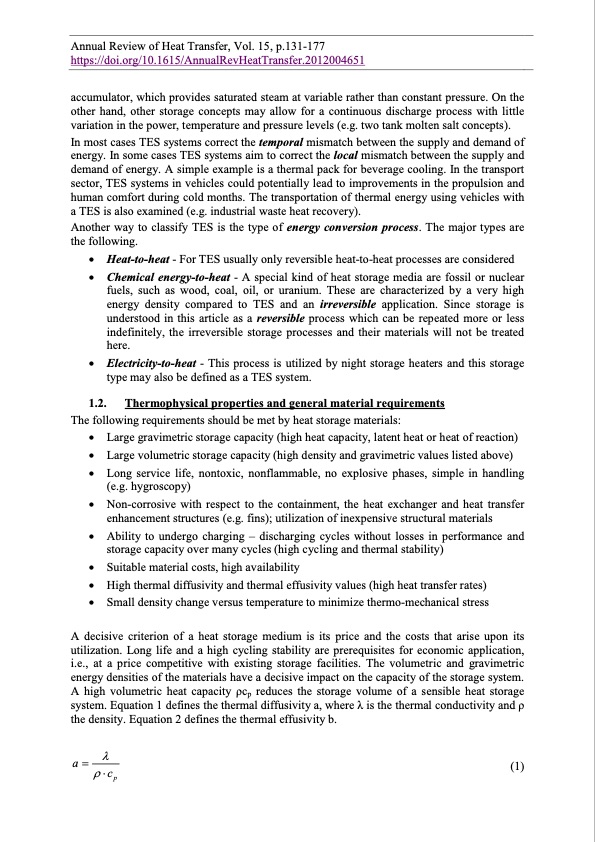
PDF Publication Title:
Text from PDF Page: 006
Annual Review of Heat Transfer, Vol. 15, p.131-177 https://doi.org/10.1615/AnnualRevHeatTransfer.2012004651 accumulator, which provides saturated steam at variable rather than constant pressure. On the other hand, other storage concepts may allow for a continuous discharge process with little variation in the power, temperature and pressure levels (e.g. two tank molten salt concepts). In most cases TES systems correct the temporal mismatch between the supply and demand of energy. In some cases TES systems aim to correct the local mismatch between the supply and demand of energy. A simple example is a thermal pack for beverage cooling. In the transport sector, TES systems in vehicles could potentially lead to improvements in the propulsion and human comfort during cold months. The transportation of thermal energy using vehicles with a TES is also examined (e.g. industrial waste heat recovery). Another way to classify TES is the type of energy conversion process. The major types are the following. Heat-to-heat - For TES usually only reversible heat-to-heat processes are considered Chemical energy-to-heat - A special kind of heat storage media are fossil or nuclear fuels, such as wood, coal, oil, or uranium. These are characterized by a very high energy density compared to TES and an irreversible application. Since storage is understood in this article as a reversible process which can be repeated more or less indefinitely, the irreversible storage processes and their materials will not be treated here. Electricity-to-heat - This process is utilized by night storage heaters and this storage type may also be defined as a TES system. 1.2. Thermophysical properties and general material requirements The following requirements should be met by heat storage materials: Large gravimetric storage capacity (high heat capacity, latent heat or heat of reaction) Large volumetric storage capacity (high density and gravimetric values listed above) Long service life, nontoxic, nonflammable, no explosive phases, simple in handling (e.g. hygroscopy) Non-corrosive with respect to the containment, the heat exchanger and heat transfer enhancement structures (e.g. fins); utilization of inexpensive structural materials Ability to undergo charging – discharging cycles without losses in performance and storage capacity over many cycles (high cycling and thermal stability) Suitable material costs, high availability High thermal diffusivity and thermal effusivity values (high heat transfer rates) Small density change versus temperature to minimize thermo-mechanical stress A decisive criterion of a heat storage medium is its price and the costs that arise upon its utilization. Long life and a high cycling stability are prerequisites for economic application, i.e., at a price competitive with existing storage facilities. The volumetric and gravimetric energy densities of the materials have a decisive impact on the capacity of the storage system. A high volumetric heat capacity ρcp reduces the storage volume of a sensible heat storage system. Equation 1 defines the thermal diffusivity a, where λ is the thermal conductivity and ρ the density. Equation 2 defines the thermal effusivity b. a cp (1)PDF Image | Annual Review of Heat Transfer

PDF Search Title:
Annual Review of Heat TransferOriginal File Name Searched:
2012_Thermal_Energy_Storage_Materials_and_Systems.pdfDIY PDF Search: Google It | Yahoo | Bing
Turbine and System Plans CAD CAM: Special for this month, any plans are $10,000 for complete Cad/Cam blueprints. License is for one build. Try before you buy a production license. More Info
Waste Heat Power Technology: Organic Rankine Cycle uses waste heat to make electricity, shaft horsepower and cooling. More Info
All Turbine and System Products: Infinity Turbine ORD systems, turbine generator sets, build plans and more to use your waste heat from 30C to 100C. More Info
CO2 Phase Change Demonstrator: CO2 goes supercritical at 30 C. This is a experimental platform which you can use to demonstrate phase change with low heat. Includes integration area for small CO2 turbine, static generator, and more. This can also be used for a GTL Gas to Liquids experimental platform. More Info
Introducing the Infinity Turbine Products Infinity Turbine develops and builds systems for making power from waste heat. It also is working on innovative strategies for storing, making, and deploying energy. More Info
Need Strategy? Use our Consulting and analyst services Infinity Turbine LLC is pleased to announce its consulting and analyst services. We have worked in the renewable energy industry as a researcher, developing sales and markets, along with may inventions and innovations. More Info
Made in USA with Global Energy Millennial Web Engine These pages were made with the Global Energy Web PDF Engine using Filemaker (Claris) software.
Sand Battery Sand and Paraffin for TES Thermo Energy Storage More Info
| CONTACT TEL: 608-238-6001 Email: greg@infinityturbine.com | RSS | AMP |